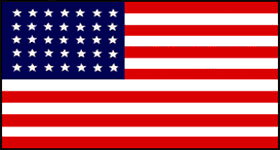 |
Civil War Battles |
|
State War Records |
| AL - AK - AZ - AR - CA - CO - CT - DE - FL - GA - HI - ID - IL - IN - IA - KS - KY - LA - MA - MD - ME - MI - MN - MS - MO - MT - NE - NV - NH - NJ - NM - NY - NC - ND - OH - OK - OR - PA - RI - SC - SD - TN - TX - UT - VT - VA - WA - WV - WI - WY |
The Battle of Jonesborough
August 31- September 1, 1864 in Jonesborough, Georgia
 |
|||||||||||||||||
|
For a month, Maj. Gen. William T. Sherman had tried to capture Atlanta using cavalry and artillery to no avail. Maj. Gen. John B. Hood's Army of Tennessee had clung to its lifeline, the Macon & Western Railroad, using it to resupply the Confederate troops in the Gateway City. Two things weighed heavily on Sherman's mind. Pres. Lincoln needed a victory prior to the 1864 Presidential election and Sherman needed Atlanta. It would be impossible to achieve his goal of "saltwater" without this north Georgia rail hub.
Sherman had successfully cut Hood's supply lines in the past by sending out detachments, but the Confederates quickly repaired the damage. In late August, Sherman determined that if he could cut Hood's supply lines—the Macon & Western and the Atlanta & West Point Railroads—the Confederates would have to evacuate Atlanta. Sherman, therefore, decided to move six of his seven infantry corps against the supply lines.
Six divisions totaling 60,000-plus men were making a semi-circle around the city to small town of Jonesborough, Georgia. By cutting the railroad that Hood depended upon for supplies, Sherman hoped to force the well-entrenched Confederates to retreat.
Only Henry Slocum's XX Corps remained in the vicinity of Atlanta. The army began pulling out of its positions on August 25, with minimal food, clothes and munitions, to hit the Macon & Western Railroad between Rough and Ready and Jonesborough. The move only took 4 days. To counter the move, Hood sent Lt. Gen. William J. Hardee with 2 corps to halt and possibly rout the Union troops, not realizing Sherman's army was there in force.
By nightfall on August 30, Confederate troops began to take positions west of Jonesboro, preparing to attack, however, a large force was delayed by advancing Union soldiers north of the city. It would not be until 1:30 P.M. on the afternoon of the 31st that Hardee and Lee were in place and ready to attack. As Patrick Cleburne advanced and engaged the Federals from the north, S. D. Lee ordered his corps to advance from the west. Disheartened from bloody attempts to take Union entrenchments at Utoy Creek, East Atlanta and Peach Tree Creek, these veterans stopped when they came under heavy fire. Cleburne's attack was more successful than Lee's. In command of Hardee's Corps, the Arkansas Irishman advanced, broke through the outer Union lines and crossed the Flint River, capturing 2 pieces of artillery. Lee's unsuccessful assault spelled the end to Cleburne's advance, as he had to withdraw to support his brethren in gray.
After the attack of Lee's and Hardee's Corps on the Union entrenchments west of Jonesboro during the afternoon of the 31st, Hood made a series of errors. Hood sent orders for Hardee to "...return Lee's Corps to this place [Atanta]." Hood knew that the Union trenches were only lightly defended by Slocum's XX Corp's. Additionally, both the commander of the remaining Confederate cavalry and Hardee himself had informed Hood that significant amounts of Union forces were threatening his rear. With Gen. Joseph Wheeler and his cavalry off disrupting the rear echelons, Hood refused to believe the only reliable reports of troop strength and location that he had and arrogantly reinforced himself.
On the 31st, Hardee attacked 2 Union corps west of Jonesborough but was easily repulsed. Fearing an attack on Atlanta, Hood withdrew 1 corps from Hardee's force that night.
Hardee faced a logistical nightmare with 60,000 Union soldiers concentrating south of Atlanta, with some of the best forces marching on his position. Ordinance and subsistence trains, hastily sent south for protection from the Atlanta attack envisioned by Hood, only "encumbered" Hardee with additional problems, since they could not travel unescorted because of Union cavalry. The attack was commanded by Sherman personally. Jonesboro offered no natural defense perimeter and Hardee did not have the time to construct additional defenses. Finally, with the rail lines cut the Confederate Army was preparing to move to Lovejoy [Station] on the Macon & Western Railroad south of Jonesboro, so "Old Reliable" was, in essence, fighting a rear guard action on September 1st.
The next day, a Union corps broke through Hardee' s troops which retreated to Lovejoy's Station, and on the night of September 1, Hood evacuated Atlanta. Sherman did cut Hood's supply line but failed to destroy Hardee's command. Sherman hoped to strike a devastating blow against Hardee by cutting off his line of retreat, but the swarthy Cajun easily outfoxed the red-haired Ohioan and withdrew to a strong position some seven miles south of the city. The battle of Jonesboro was over.
